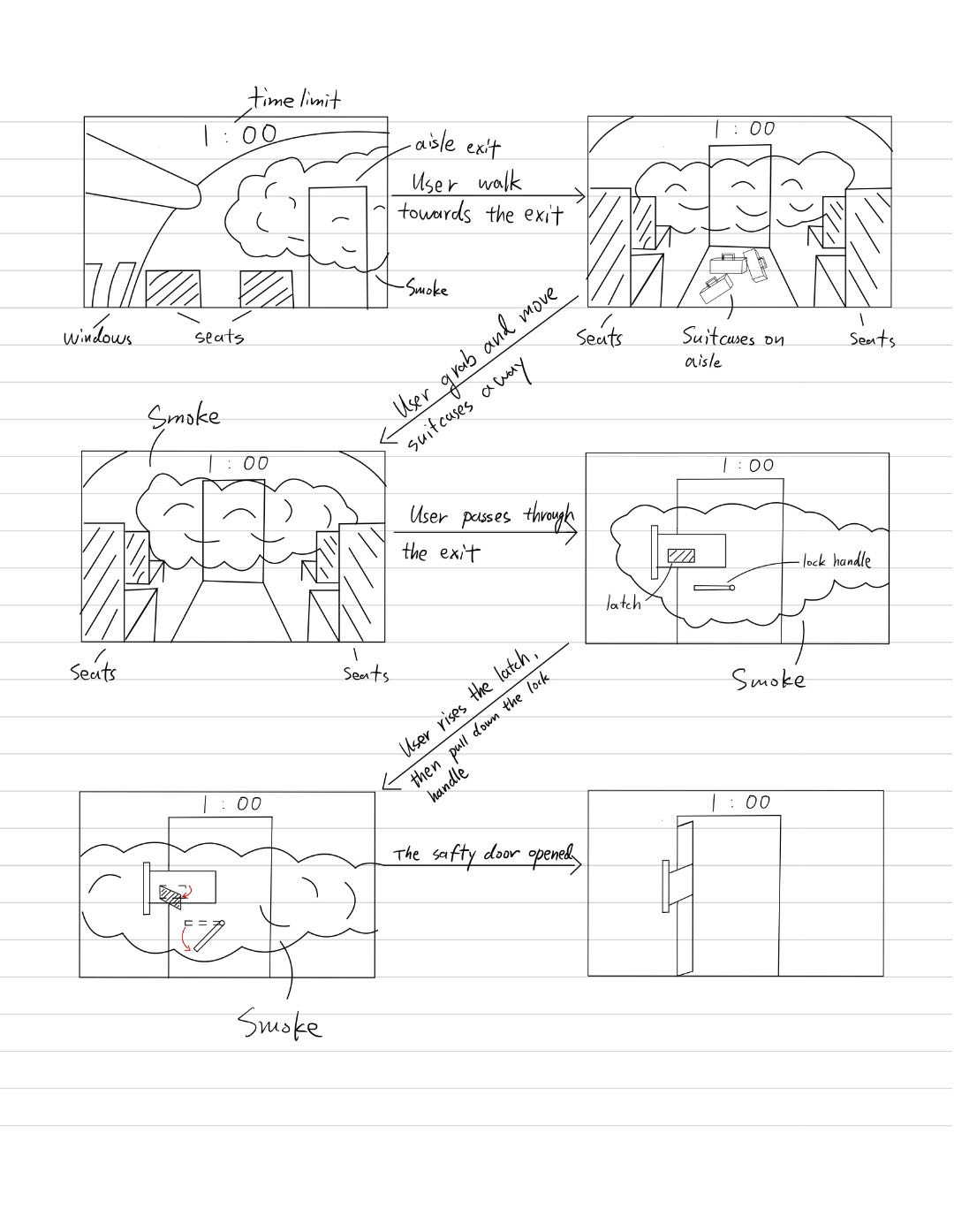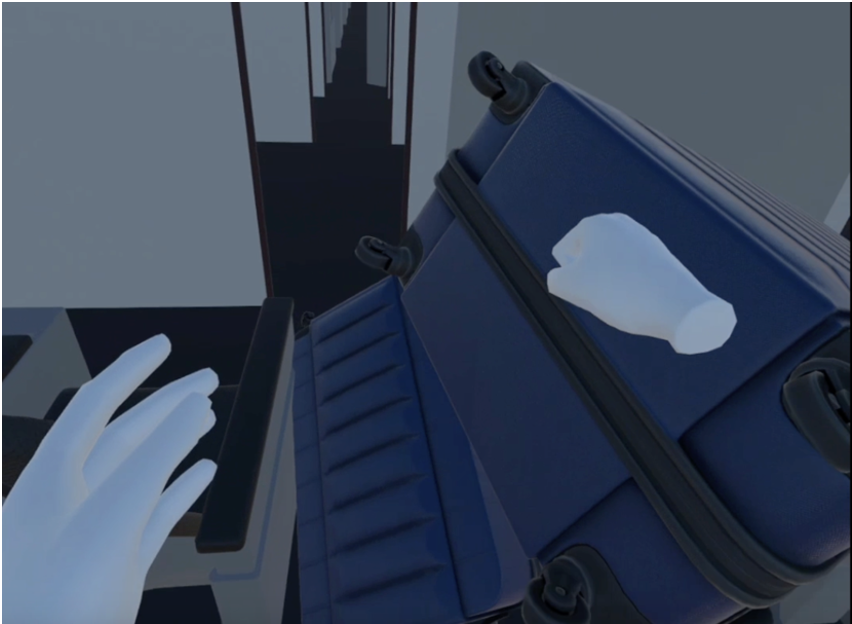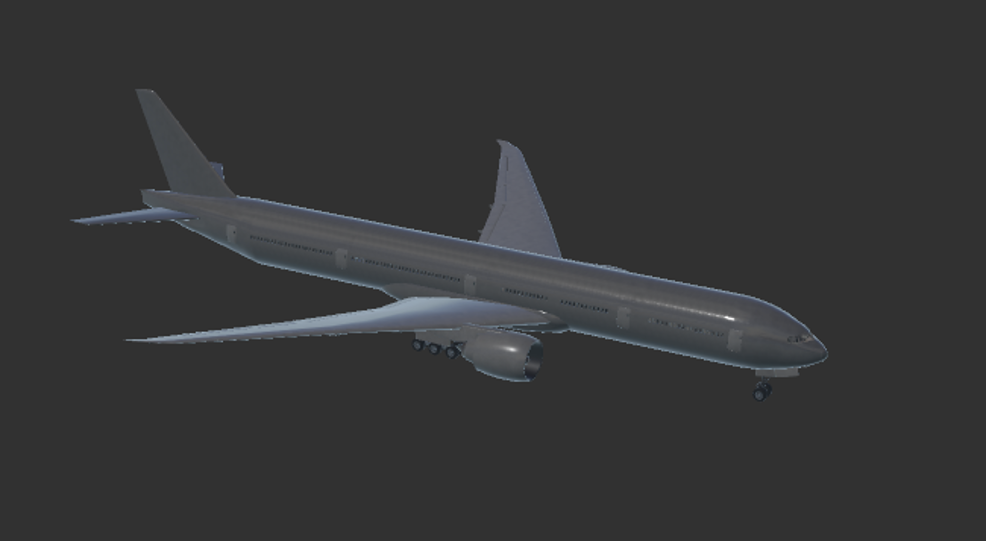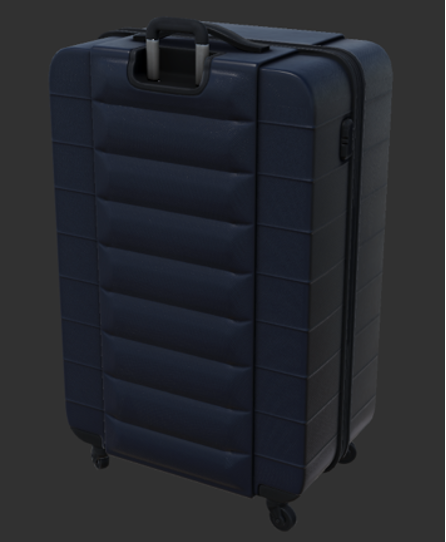Assignment 4 Report
Assignment 4 Report
1. Introduction
“1-minute test, safer journey.”
2. Description of the application
The "Cabin Evacuation Simulation" project builds a VR environment to simulate the real cabin of a commercial passenger aircraft to help airlines evaluate to educate passengers to become familiar with the aircraft's emergency exits and enable them to evacuate according to the prescribed emergency procedures when required, ensuring safety and efficiency during real-life emergencies.
Airlines always encounter the challenge of ensuring safety while maintaining the budget. Traditional ways of teaching people how to evacuate can be pricey, challenging to organize, and sometimes difficult to simulate an emergency environment. That is why most airlines show those safety videos or do a quick demo before takeoff. These methods might be helpful, but they need to give passengers the hands-on experience they need to remember what to do (Smith, 2011).
The "Cabin Evacuation Simulation" using VR technique is both a demo and a full-blown experience. Passengers get to practice evacuating in a real-life setting, which helps them remember the steps better. If a real emergency happens, passengers are more prepared and less likely to panic (Jones et al., 2015). It also creates a vivid and immersive experience. It feels like what passengers might face during an emergency, from the visuals to the sound. This is about remembering the steps and mentally gearing up for the intense emotions of a real-life evacuation. Additionally, there is the bonus of being able to try the simulation over and over. Each time can be a bit different, with changes in smoke, obstacles, or the type of emergency, ensuring passengers are ready for all emergencies.
In addition, cost-effectiveness is another advantage of applying this technology to airline companies. Once the VR program is made, it can be used repeatedly, and companies will not need to spend money on real-life drills or making new training materials. Furthermore, this VR program is also super flexible. Airlines can adjust the program to show different plane designs, seating arrangements, and types of emergency exits. This means passengers learn precisely what they need to know for their specific flight, making the training even more helpful.
On the other hand, it's for more than just passengers. Flight attendants, pilots, and other crew members can use the simulation to sharpen their skills, get a feel for what passengers might struggle with, and develop the best plan for real emergencies.
3. Design of the Interface Solution
In a real-life environment, simulating emergency evacuation on an aircraft is very expensive and time-consuming, and conducting real aircraft evacuation training is commercially unviable, especially for large civilian aircraft. Since each aircraft model has its own emergency procedure, specifications, and design, most passengers lack understanding of the aircraft configuration and how to use emergency exits. In emergencies where occupants are uninjured and the cabin environment is intact, the survival of passengers is primarily determined by their ability to move from seat to exit (Snow et al. 1970). In an emergency evacuation, the lack of understanding of the environment can cause panic among evacuees, ultimately reducing evacuation efficiency. Virtual reality can provide a safe environment, is low-cost, can be reused, and is therefore suitable for learning appropriate evacuation and rescue procedures (Kinateder et al. 2014; Tang et al. 2009). We offer two design solutions for simulating emergency evacuation scenarios to reduce costs and simplify the process. Both solutions will utilize the VR headsets as a training aid to enter the collaborative VR environment of a passenger aeroplane cabin.
The first design model is to place luggage obstacles that have fallen due to mid-air turbulence or mechanical failure in a narrow passage. To reduce emergency evacuation time, passengers must manually, quickly, and accurately remove the luggage by operating Touch Controllers and comply with the escape rules for abandoning luggage. This design is based on the incident of an emergency landing of a Boeing 777 passenger plane in the UK in 2015, due to the large number of passengers carrying cabin baggage, the emergency evacuation was delayed, and a passenger was seriously injured. Even an aircraft carrying passengers with a small number of cabin baggage will significantly cause the total evacuation time to exceed the certification threshold (Hodgson et al. 2023).
In the second design model, we selected an Airbus emergency hatch model from the Unity material library to create a realistic environment, including two handles. The upper spring handle is used to arm or disarm the slide, and the lower push handle is used to open the hatch. Passengers can interact with simulated door handles to enhance their understanding of operating the emergency door opening procedures.
In VR, avatars and agents simulate human behaviour to achieve tasks that cannot be completed due to various real-world conditions, which has considerable cost advantages. VR is increasingly used in emergency preparedness training in the form of 3D interactive simulations of emergency scenarios. They can effectively improve the emergency preparedness of ordinary citizens, using aviation safety as a relevant case study. Changing specific visual and auditory characteristics (releasing smoke and adding alarm sound effects) can create different emotional versions of the same experience, thereby increasing the user's stimulation level. In an emergency evacuation scenario, choosing the evacuation exit intuitively or blindly without guidance is often poor. It may also cause panic among evacuees, leading to passengers' abnormal behaviours and ultimately reducing evacuation efficiency. VR technology allows users to experience an environment that simulates multiple sensory channels, allowing them to feel in a real cabin environment. Thus, they gain experience and knowledge while interacting with the virtual environment.
4. Interaction Design
The storyboard below illustrates a sequence of events for users navigating through a smoky environment within an aeroplane setting. The design can be broken down into the following interactive stages:
- Time Awareness: At the top of each frame, a countdown timer labelled "time limit" shows the situation's urgency, emphasising the need for quick action.
- Navigating the Aisle: The user starts by walking towards the exit. This stage involves physical movement, and the challenges posed by the smoke limit visibility and may hinder the user's ability to locate the exit promptly.
- Obstacle Removal: As the user progresses, suitcases on the aisle pose an obstruction. The user must grab and move these suitcases out of the way to clear the path. This interaction ensures safety and efficiency as the user can proceed without hindrance.
- Safety Door Mechanism: On reaching the exit door, the user interacts with the safety door's mechanism. This involves two distinct actions:
- Lifting the Latch: The latch must first be raised to unlock the door.
- Pulling Down the Handle: Once the latch is lifted, the handle must be pulled down to open the door fully.
 In this stage, some of the features, such as the time limit, the smoke effect, and the full implementation of the safety door, still need to be completed. They will be added in the subsequent implementation phase.
In this stage, some of the features, such as the time limit, the smoke effect, and the full implementation of the safety door, still need to be completed. They will be added in the subsequent implementation phase.5. Initial Technical Development
5.1. Interface technology used
- Oculus
- Unity UI
5.2. Interaction engagement
Action Description | Image |
The user grabs the suitcase on the passenger aisle and moves it to the side. |
|
The user pokes the safety door, and the door opens. |  |
6. Initial 3D models
Name | Description | Image |
Airliner | The flight model involves all the interior elements |
|
Suitcase | The suitcase model |
|
7. Conclusion
The "Cabin Evacuation Simulation" is a VR Unity project designed to train passengers on emergency escape procedures during forced landings. Using virtual reality, the application replicates the cabin environment of a commercial aeroplane, educating passengers about emergency exits and evacuation procedures. The interface solution includes two primary designs: one simulating luggage obstacles in the aisle that passengers must remove and the other emphasizing interactions with an Airbus emergency hatch for a realistic exit experience. By leveraging VR technology, this application offers a cost-effective and safe method to familiarize passengers with aircraft emergency scenarios, ensuring quicker and more efficient evacuations when needed.
Reference
C. C. Snow, J. J. Carroll, M. A. Allgood, Survival in emergency escape from passenger aircraft, Tech. Rep. AM 70-16, Civil Aerospace Medical Institute, viewed 5 October 2023, https://www.faa.gov/data_research/research/.med_humanfacs/oamtechreports/1970s/m... (1970).
C.-H. Tang, W.-T. Wu, and C.-Y. Lin, “Using virtual reality to determine how emergency signs facilitate way-finding.,” Appl. Ergon., vol. 40, no. 4, pp. 722-30, Jul. 2009.
D. Hodgson, C. Tonge, M. Amos. 2023, “Impact of baggage collection behaviour on aircraft evacuation.,” arXiv:2303.03264 [cs.MA], viewed 7 October 2023, https://doi.org/10.48550/arXiv.2303.03264.
Jones, R., Lee, K., & Hollands, J. (2015). The effectiveness of virtual reality in evacuating aircraft passengers. Human Factors Journal, 57(5), 845-856.
M. Kinateder, E. Ronchi, D. Nilsson, M. Kobes, M. Müller, P. Pauli, and A. Mühlberger, “Virtual Reality for Fire Evacuation Research,” pp. 313-321, Sep. 2014.
Slater, M & Wilbur, S 1997, A framework for immersive virtual environments (FIVE): Speculations on the role of presence in virtual environments. Presence: Teleoperators & Virtual Environments, 6(6), 603-616.
Smith, J. (2011). Virtual Reality and its role in removing the barriers that limit access to a safe evacuation in emergencies. Journal of Safety Research, 42(3), 195-203.
Unity 3D model packages:
- Airliner: https://assetstore.unity.com/packages/3d/vehicles/air/airliner-aircraft-with-int... (By Mixall):
- Airliner.prefab: Assets/Airliner - aircraft with interior/models/Prefab/Airliner.prefab
- Suitcase Free: https://assetstore.unity.com/packages/3d/props/interior/suitcase-free-206851 (By Moon Studio):
- Suitcase.prefab: Assets/Moon Studio/Suitcase/Suitcase_Prefabs/Suitcase.prefab
ChatGPT: We did not apply ChatGPT for this assignment.



Leave a comment
Log in with itch.io to leave a comment.